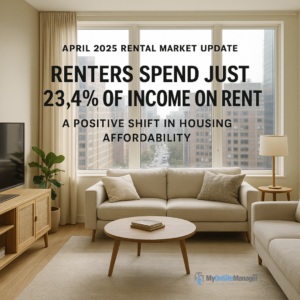Housing affordability remains a critical issue for millions of Americans, but new data brings encouraging news for renters. According to a recent report, the average U.S. renter household spent just 23.4% of its income on rent in April 2025, marking a notable improvement from the 24.7% share recorded in April 2024. This trend places the average renter well below the widely accepted “30% affordability rule”, which suggests that households should spend no more than 30% of their gross income on housing costs to avoid financial strain.
This positive shift is the result of several key factors, including stabilizing rent prices, growing household incomes, and increased rental housing supply, which together have helped ease the burden of housing expenses for many families.
The ‘30% Rule’ and Why It Matters
The 30% rule has long been considered the benchmark for housing affordability. If a household spends over 30% of its income on rent, it is often labeled as “rent-burdened,” leaving less money for other essentials like food, transportation, healthcare, and savings.
-
In April 2025, the national rent-to-income share of 23.4% indicates that, on average, renters are not overextended financially.
-
This drop from 24.7% in 2024 reflects a combination of slower rent growth and higher median household incomes, both of which have contributed to easing rental pressures.
National Rent Trends in April 2025
-
Median Asking Rent: The national median asking rent was $1,699 in April 2025, a slight $5 increase from March, but still $60 below the peak in August 2022.
-
Long-Term Perspective: Despite recent declines, rents remain roughly 20% higher than pre-pandemic levels. This means renters are still paying more compared to 2020, but their income growth has made these costs relatively more manageable.
-
Vacancy Rates: With more multifamily housing developments entering the market, vacancy rates have increased, leading to more competitive pricing and slower rent hikes.
Regional Highlights: Where Rent Is Still a Challenge
While the national average shows improvement, not all metro areas are equally affordable. Some cities still exceed the 30% rule, with coastal markets topping the list of most rent-burdened locations.
-
Miami-Fort Lauderdale has the highest rent-to-income ratio at 37.9%, meaning the average renter in this market spends more than a third of their income on housing.
-
New York City follows closely at 37.1%, with other high-cost areas including Los Angeles, Boston, and San Diego also surpassing the affordability threshold.
-
On the other hand, more affordable metros like Oklahoma City, Austin, Raleigh, Minneapolis, and Columbus have rent shares well below the 30% benchmark, offering more financial breathing room for residents.
Why Affordability Is Improving
Several factors have contributed to the nationwide easing of rental burdens:
-
Increased Housing Supply:
A surge in multifamily construction projects over the last two years has expanded rental options, driving more competition and stabilizing rent prices. -
Slowing Rent Growth:
Since peaking in 2022, rent growth has moderated significantly. In some cities, rents have even declined year-over-year, providing welcome relief. -
Rising Household Incomes:
With wages steadily increasing, renters can now allocate a smaller portion of their paychecks to housing, especially in mid-tier cities. -
Shifting Housing Demand:
Migration trends have shifted some rental demand away from expensive coastal cities to more affordable inland markets, further balancing national rent averages.
Implications for Renters and the Market
-
For Renters: This is an ideal time to explore lease renewals or move into new rentals, as the market is currently more balanced than it has been in years.
-
For Investors: While rent growth is cooling, occupancy remains stable, and demand for quality rental units continues to be strong, particularly in growing secondary markets.
-
For Policymakers: The improvement highlights the importance of policies that encourage housing construction, zoning reforms, and affordable housing initiatives.
Looking Ahead: Will This Trend Continue?
Experts suggest that rental affordability is likely to hold steady or improve slightly in the coming months, as more apartment complexes reach completion and competition among landlords increases. However, macroeconomic factors such as interest rates, inflation, and job growth will continue to influence the market. Additionally, high-cost metros will remain challenging for renters unless there are significant policy or supply-side changes.
Conclusion
The fact that renters spent only 23.4% of their income on rent in April 2025—well below the 30% threshold—is an encouraging sign of improved affordability. While challenges remain, particularly in expensive urban markets, the national trend suggests that renters today have more breathing room than they did just a year or two ago. With continued income growth and expanding housing supply, the rental market is becoming more balanced, giving both renters and landlords an opportunity to plan for a more stable future.
Source: Original Article: Renters Spent 23.4% of their Incomes on Rent in April, Significantly Under the ‘30% Rule’

